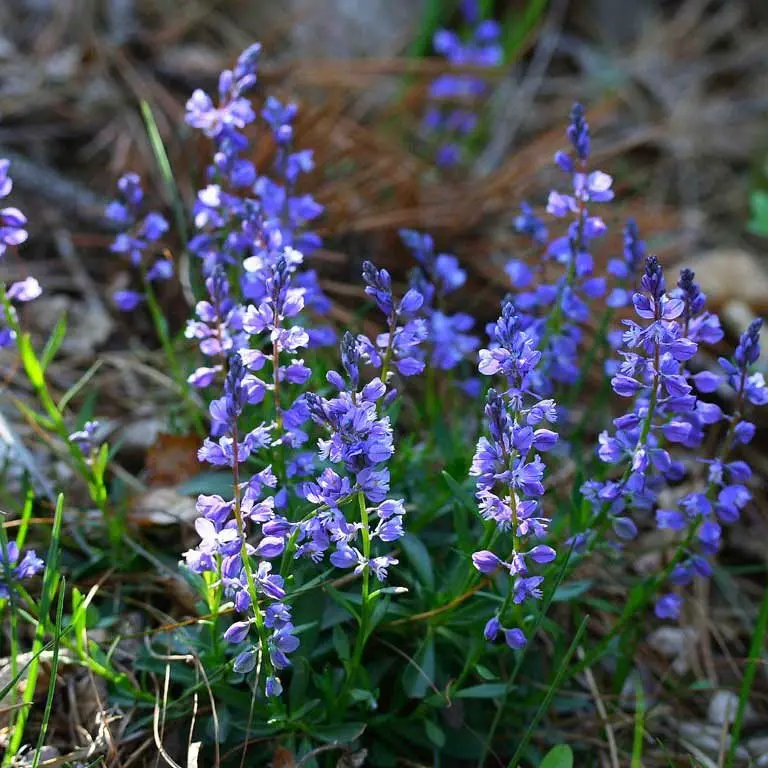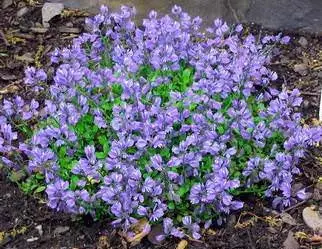Contents
Useful properties and application of source
Botanical characteristics of source

stop – a perennial dicotyledonous plant with non-branching erect stems 15–30 cm high. The leaves are alternate, sessile, lanceolate, forming a noticeable basal rosette at the base. The flowers are zygomorphic, on short pedicels, blue, white, rarely reddish, with oval-elongated petals (5–7 mm), forming racemes on the tops of the branches. The flowering period is May-June, the fruits ripen in July-August. The fruits are oblique heart-shaped capsules, laterally flattened. Seeds glabrous or hairy, with seed.
It grows in almost all temperate warm zones. The plant prefers moist soils and bright places. Istod can be found along roadsides, along river terraces and slopes, in pastures and even in dry meadows.
Useful properties of source
Istod is widely used in folk medicine, despite the fact that it contains a lot of bitter substances. For the preparation of medicines, the aerial part and roots are used. Leaves and flowers are cut during flowering, the roots are dug up later. The grass is dried under a canopy or indoors with free access of air, stored in a dry place.
The roots and rhizomes contain saponins (up to 6%), including an amorphous mixture known as “senegin”. The roots also contain a lot of tannins and dyes, essential and fatty oils, polygallic acid. Ascorbic acid and flavonoids were found in the leaves. The plant has a choleretic, antidiabetic, expectorant, antisclerotic and wound healing effect. According to ancient Chinese teachings, its regular use contributes to longevity.
Application of source
Decoctions and infusions are prepared from the roots, used as an expectorant in the treatment of bronchial asthma, pneumonia, chronic bronchitis, and emphysema. They increase the secretion of mucous bronchi, which leads to liquefaction of mucus. Root decoctions are also good for cystitis. Herbal infusions are used for diarrhea, catarrh of the stomach and intestines, as well as for appetite. They are able to increase lactation in lactating women.
Leaf infusions are soothing and beneficial in convulsions, they are useful in impotence and memory loss, as an anti-febrile agent. In the form of poultices and rubbing, herbal infusions are prescribed for abscesses and eczema.
Root decoction: 8 g of dry crushed roots should be poured with a glass of boiling water and boiled in a water bath for 20–30 minutes, then let it brew, and then strain and bring the resulting broth to its previous volume by pouring boiled water into it. The medicine should be taken 30 minutes before meals 4 times a day, 1 tablespoon.
Infusion of flowers and leaves: 1 teaspoon of chopped grass is poured with 400 ml of boiling water, infused for 2 hours and filtered. Dosage: 10-15 minutes before meals take 100 mg of infusion 4 times a day.
Herbal tea: 2 teaspoons of dried leaves and flowers are poured into 1/3 cup of boiled water, brought to a boil and filtered after 1-2 minutes. Tea can be drunk one cup 2-3 times a day, sweetened with honey.
root of source
When harvesting roots and rhizomes, they are carefully dug out of the ground and cleaned well (can not be washed!). Dry raw materials in the open air in the shade, in a room with ventilation or in dryers at a temperature of 45-50 ° C. After drying, the roots are shaken again on special sieves to completely remove the remaining soil. Store dried roots in cloth bags in a dry place, the shelf life of raw materials is up to three years. Harvesting of roots is carried out from August to September.
For a long time, the roots of the source were imported to Russia, but over time, domestic botanists investigated local plant varieties and came to the conclusion that they also have excellent medicinal properties.
Eastad East

Istod Siberian grows in the steppe and forest-steppe zones of the southeastern European part of Russia, in Eastern and Western Siberia, in the Far East and the Caucasus. This small perennial plant has thin, short hairy, more or less bushy stems. The upper leaves are lanceolate, the lower ones are elliptical, pointed at the ends. The sepals are green with whitish edges, the corolla is blue or light purple. The plant blooms from late May to mid-June.
The roots of this type of source contain saponins, tannins, salicylic acid methyl alcohol, fatty oil, glycosides. Medicinal preparations from the roots are used for diseases of the lungs and bronchitis, for mucous diarrhea, catarrhs of the intestines and stomach. Good results are obtained with the external use of infusions and decoctions for the treatment of boils, gargling with laryngitis.
Istod myrtolistny
It is an evergreen shrub with a height of more than 1 meter. Its thin branches are densely covered with foliage. The leaves are oval, different shades of green. At the ends of short branches, the flowers are collected in small brushes. The flowers are large, purple or bright purple, similar to fluttering butterflies. This species blooms from May to September.
This South African plant needs plenty of light, we grow it in pots. The medicinal properties of this species have not been studied.
Istod thin-leaved
This type of source is found in Primorye, the Amur region, in Altai, in the southern regions of Eastern Siberia. It grows along river terraces, on rocky mountain slopes, in dry meadows. Plant height from 10 to 30 cm, it has many thin branching stems. The lower leaves are lanceolate, the upper ones narrowly linear to filiform. The flowers are bluish or light purple, on drooping pedicels, collected in sparse inflorescences. The fruits are two-celled round capsules with dark brown seeds.
Chinese folk medicine recommends decoctions from the roots of the thin-leaved isthod for heart neurosis, vegetative-vascular dystonia, diabetes mellitus, hypertension and nephritis. In Tibetan medicine, istod is used for inflammation of the kidneys and bladder, diseases of the stomach and intestines, edema, lack of appetite. As part of complex fees, it is prescribed for sleep disorders, atherosclerosis, anemia, disorders of the nervous system, vasospasm.
The roots of the thin-leaved istod are distinguished by the anomalous structure of the wood. The transverse section clearly shows the absence of a complete disc. Most often, wood makes up only 1/2 or 3/4 of the disk, the rest of the space is filled with cortical parenchyma. The roots are odorless, they have a whitish fracture, the taste is sweetish, irritating to the throat.
Istod ordinary
This species is distributed throughout the European part of Russia, in Ukraine (in the Carpathians), less often in Polissya. It grows in wet meadows, along river banks, on forest edges, in bushes. There are many stems, they are branched or simple, almost naked. Plant height 15–30 cm. The lower leaves are alternate, oval, 0,5–2 cm long, the upper ones are elongated, sessile, sharp. The flowers are five-petalled, blue, less often pinkish, collected in rare racemes. The fruits are boxes. The flowering period is June-July, the fruits ripen in July-August.
Decoctions and infusions of the common source contribute to liquefaction of sputum, have an anti-inflammatory effect and increase the secretion of bronchial glands. Remedies are prescribed based on the source for laryngitis, pneumonia, bronchial asthma and bronchitis. The positive therapeutic effect is associated with the action of triterpene saponins.
Contraindications to the use of istod
The root of istoda can irritate the gastrointestinal tract, so it is not recommended for patients with peptic ulcer and gastritis. Individual intolerance to drugs is also possible. It is contraindicated in the treatment of children under the age of three.









